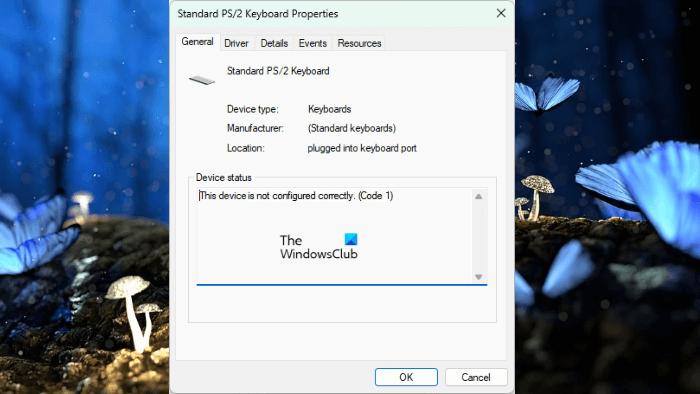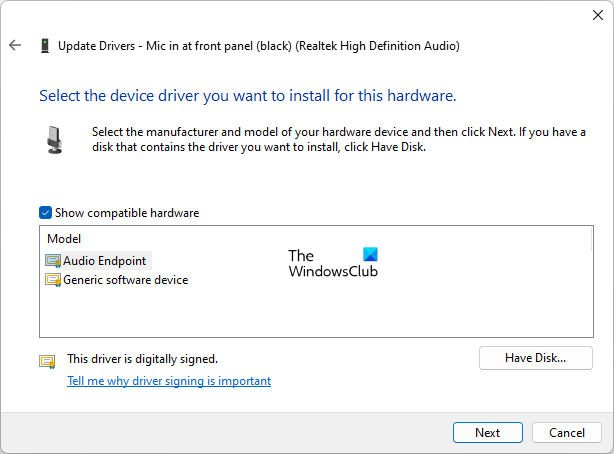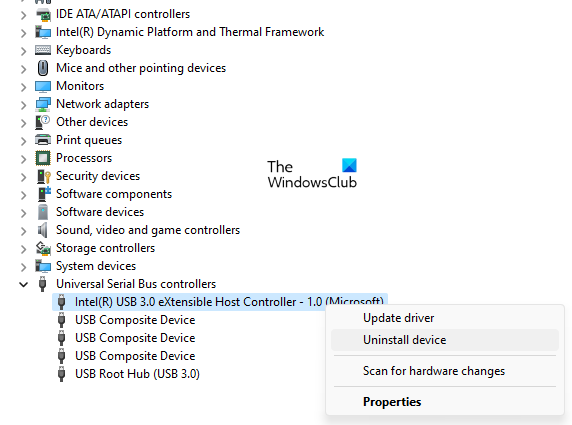You might have noticed that when you connect a new hardware device to your computer, it installs its respective driver. Your device does not work until the driver installation process is completed. A driver is a software that establishes a communication link between the hardware and the operating system. It is the driver that tells an operating system which type of device is connected to it so that the connected hardware device could work properly. When the driver malfunctions, the respective hardware device does not work. In this article, we will see some solutions to fix one of the Device Manager errors, Code 1, This device is not configured correctly.

This device is not configured correctly (Code 1)
We can view and manage all the drivers installed on our system in the Device Manager. When a particular device stops working due to an issue with the driver, we can view its respective error code in the Device Manager. Code 1, This device is not configured correctly is one of the Device Manager error codes. According to Microsoft, this error occurs due to one of the following causes:
- There are no drivers installed on your system for the particular device.
- The drivers for the particular device are not configured correctly.
If you see this error message in your Device Manager, you can try the suggestions provided below.
- Update the device driver
- Install the device driver manually
- Download the device driver from the manufacturer’s website
- Delete UpperFilters and LowerFilters in Registry (if available)
- Uninstall and reinstall the Universal Serial Bus Controllers
Let’s see all these fixes in detail.
1] Update the device driver
This is the easiest fix for the error that you are getting in the Device Manager for your hardware device. You simply have to update the device driver. This fix has worked for some users. It may work for you too. Follow the steps below:
- Right-click on the Start button and select Settings.
- In the Settings window, select the Windows Updates tab from the list on the left-hand side.
- In the Windows Updates tab, click on Advanced Options.
- Under the Additional options menu, you would find Optional updates.
- Click on it and select the updates you wish to download.
Let Windows install the latest version of your device driver. After the driver update is completed, check if the issue persists.
2] Install the device driver manually
Another solution to fix this error is to install the device driver manually. The steps to do this are as follows:

- Open the Device Manager.
- Locate your problematic device driver.
- Right-click on it and select Update driver.
- Select Browse my computer for drivers.
- Now, select Let me pick from the list of available drivers on my computer.
- Make sure that the Show compatible hardware checkbox is selected. You will see a list of compatible drivers for your device.
- Install any of the compatible drivers and see if this fixes the problem.
3] Download the device driver from the manufacturer’s website
If the above methods did not solve your issue, uninstall the currently installed driver from your system via the Device Manager. After that, visit the official website of your device manufacturer and search for the latest version of the driver for your device model and then download the driver.
If the driver is downloaded in zip format, extract it. Now, open the extracted folder. You will find an installer file there. Double-click on the installer file to install the driver manually. After installing the driver, restart your computer. This should fix the problem.
4] Delete UpperFilters and LowerFilters in Registry (if available)
If the issue still persists, delete the UpperFilters and LowerFilters values in the Registry Editor (if available). The following process involves modifying the Windows Registry. Any mistake while doing changes to Windows Registry can lead to serious errors on your system. Therefore, before you proceed, we recommend you create a system restore point and backup Windows Registry.
Click on Windows Search and type registry Editor. Select the Registry Editor app from the search results. Click Yes in the UAC prompt.
When the Registry Editor opens up, copy the following path and paste it into the address bar of the Registry Editor. After that, hit Enter.
HKEY_LOCAL_MACHINE\SYSTEM\CurrentControlSet\Control\Class\{36FC9E60-C465-11CF-8056-444553540000}
Look whether the UpperFilters and LowerFilters values are available on the right side. If yes, delete both of them. Exit Registry Editor and restart your computer.
5] Uninstall and reinstall the Universal Serial Bus Controller
Code 1, This device is not configured correctly is one of the Device Manager error codes and can occur on any of the hardware devices connected to your computer. If your USB devices are not working properly, open the Device Manager and locate your device driver. If you see a yellow exclamation mark, there is a problem with that device driver. Now, double-click on it to open its properties. If the properties dialog box shows the error code 1, uninstalling and reinstalling the Universal Serial Bus Controller can fix the problem.

If you quickly and repeatedly insert and remove a USB device into and from a particular USB port, that USB port may stop responding. The USB port does not recognize the USB device connected to the computer until it remains in this state. To fix this problem, uninstall the USB Controller and install it again. The steps for the same are written below:
- Press the Win + X keys and select Device Manager.
- In the Device Manager, double-click on the Universal Serial Bus Controllers node to expand it.
- Right-click on the first USB Controller and select Uninstall device.
- Repeat step 3 to remove all the USB Controllers. When you are done, restart your computer.
After restarting the device, Windows will detect the hardware changes automatically and install the missing USB Controller drivers on your system. Now, check if the issue persists.
Read: Touchpad error This device cannot start (Code 10)
How do you fix this Device is not configured correctly code 1?
You may see the “This device is not configured correctly. (Code 1)” error message in the Device Manager when there is no driver installed on your system or when the driver for your device is not configured correctly. To fix this error, you have to update your device driver. There are many ways to update a device driver. You can do so via the Device Manager or via the Windows Optional Update feature.
If updating the driver does not solve your problem, visit the official website of your device manufacturer and download the latest version of your device driver. Now, you can manually install the driver you have just downloaded. But before you proceed, you have to uninstall the driver currently installed on your system.
How do I fix the Device Manager error?
The Device Manager shows different error codes for different driver errors on a Windows computer. When a particular device stops functioning properly, you may see a yellow exclamation mark for that device driver in the Device Manager. This warning sign is an indication that the device driver has stopped working properly.
To fix that Device Manager error, double-click on the problematic device driver in the Device Manager. This will open its properties. Under the General tab, you will see the error message along with the error code in the Device Status box. You can search for that particular error code and error message on the web to know the possible fixes to resolve that error.
Sometimes, the error in the Device Manager also occurs due to the corrupted or outdated device drivers. In such cases, updating or reinstalling the device driver fixes the problem.
Read: Code 12, This device cannot find enough free resources that it can use.
How do you know if your hardware is damaged?
There are some warning signs that will tell you that your PC hardware is going to fail. You will see frequent Blue Screen of Death errors on your system, you will face performance issues, your system slows down sometime after you start it, you will experience frequent heating issues, etc.
Hope this helps.
Read next: The Driver for this device might be corrupted or System may be low on memory (Code 3).
Leave a Reply